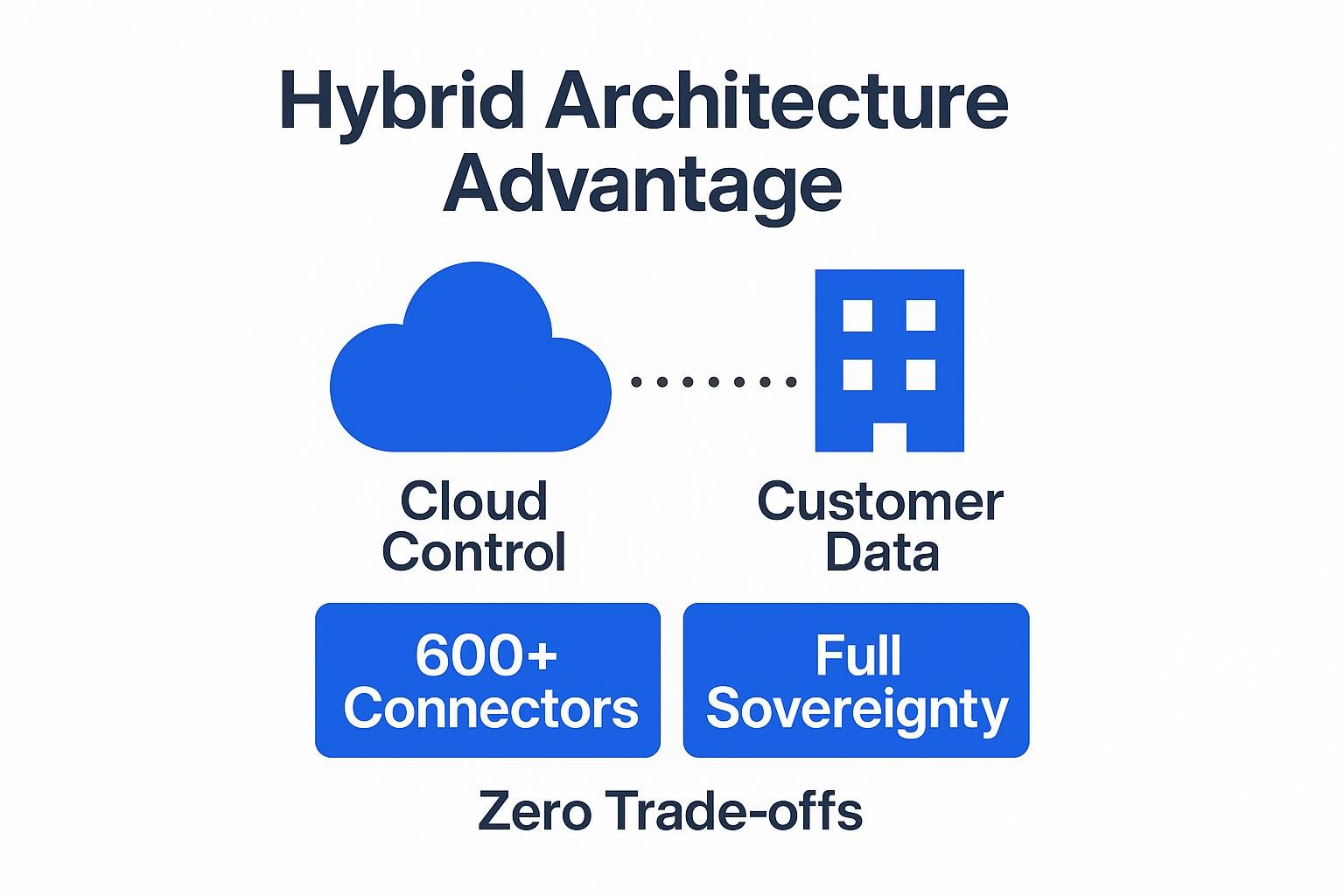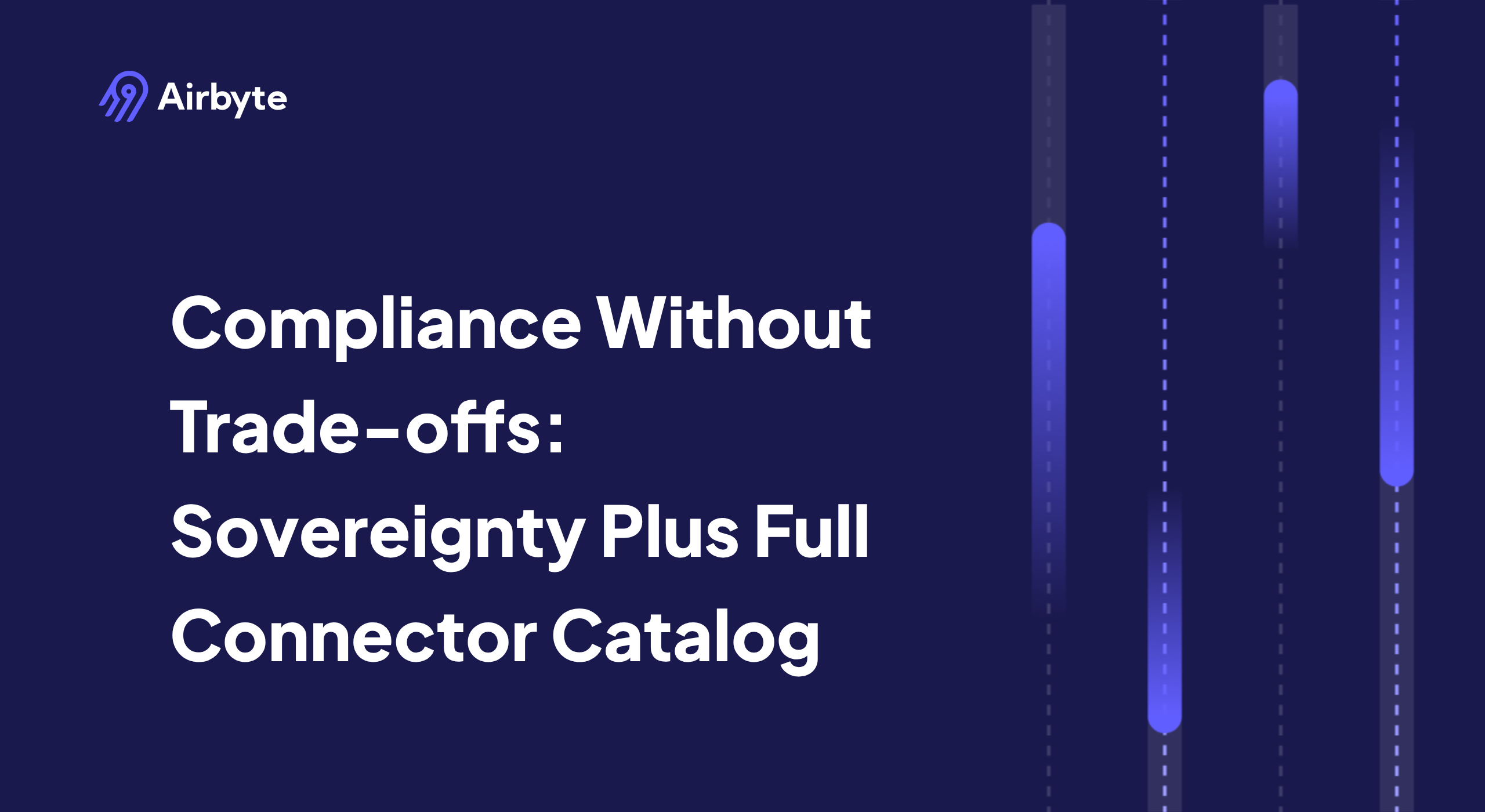Compliance Without Trade-offs: Sovereignty Plus Full Connector Catalog
Summarize this article with:
✨ AI Generated Summary
You face an impossible choice: regulators demand that sensitive records stay inside your walls, yet business units keep adding SaaS tools that need immediate access to that same data. Cloud platforms promise hundreds of ready-made connectors but clash with strict data sovereignty laws. On-premises platforms protect compliance but force you to build custom pipelines for every new source. The result is stalled projects and mounting risk.
Healthcare teams safeguard PHI according to HIPAA-compliant controls, banks implement regional strategies for PCI data in response to broader regulations, and defense contractors live under export controls. Each scenario forces a challenging balance between control and capability. The backlog of missing connectors grows, engineers babysit brittle integrations, and audit teams scramble when data crosses unseen borders.
A true hybrid architecture ends this compromise. By separating a cloud control plane from customer-controlled data planes, you keep every record inside compliant boundaries while accessing a comprehensive connector catalog at full speed and quality. Enterprises can finally have both sovereignty and connectivity.
Why Compliance Has Historically Meant Compromise?
The traditional approach creates an immediate tension: cloud integration platforms offer hundreds of ready-made connectors, yet the moment sensitive records cross the public internet you risk violating HIPAA, PCI DSS, or GDPR. Keeping everything on-premises avoids that exposure, but the trade-off is brutal: few pre-built connectors, manual upgrades, and a backlog of feature requests that never seems to shrink.
These constraints manifest in concrete operational challenges:
- Fragmented data stacks as teams spin up one-off pipelines to stay within jurisdictional boundaries
- Projects stall for weeks while engineers reverse-engineer APIs instead of improving models
- Audit preparation becomes a scramble because logs live in multiple environments
- Data crosses borders it shouldn't have, creating compliance violations
Healthcare providers blocking SaaS ingestion of PHI, banks sidelining cloud analytics to protect cardholder data, and defense contractors enforcing ITAR restrictions all illustrate the same dilemma. As data volumes rise and regulations tighten, that compromise only grows more costly, making a different architectural approach not just attractive, but necessary.
How Hybrid Deployment Enables Compliance Without Trade-offs?

Hybrid architecture solves the sovereignty problem by keeping data processing separate from orchestration.
Control and Data Plane Separation
This architectural challenge finds its solution in a hybrid model that fundamentally separates orchestration from data movement. The cloud-managed control plane handles scheduling, monitoring, and configuration, while your data plane runs every connector and processes every record inside your VPC or data center.
Key security characteristics:
- Sensitive data and credentials never leave your environment
- You manage pipelines from a single web UI
- Your data plane initiates outbound HTTPS calls to the control plane
- Firewalls stay closed to inbound traffic, reducing attack surface
Compliance Benefits
The compliance benefits become immediately apparent:
- HIPAA or PCI data stays on systems you already harden
- GDPR workloads remain within the correct geographic region by spinning up regional data planes
- Centralized orchestration gives you uniform RBAC, lineage, and alerting across every location
- The control plane hosts no production data, so audits focus on your own infrastructure
Operational Advantages
Operationally, you avoid maintaining monolithic on-premises software while keeping regulated data out of multi-tenant clouds. Performance scales predictably: when a region needs more throughput, you add compute to that specific data plane without touching other sites. You can adopt new connectors the same day they ship, with no code changes needed for integration, though your compliance teams may still need to review each new connector for regulatory requirements. Neither pure cloud nor pure on-premises approaches can match this flexibility.
Cloud vs On-Prem vs Hybrid: Compliance and Capability Comparison
This comparison reveals how hybrid architecture combines cloud-level agility with on-premises sovereignty, eliminating the traditional choice between compliance and capability.
Why the Full Connector Catalog Matters for Compliance?
Three common scenarios show how limited connector libraries create unforced compliance violations.
Incomplete Coverage Creates Compliance Gaps
Connector coverage becomes critical when you realize that compliance gaps often emerge from incomplete data visibility. Modern enterprises run dozens or hundreds of SaaS apps, legacy databases, and regional systems, each producing compliance-relevant records. When your integration platform offers only a short list of connectors, you're forced into risky workarounds that fragment oversight and invite audit findings.
Manual Workarounds Introduce Risk
Data teams end up exporting CSVs by hand, building brittle scripts, or spinning up shadow pipelines that live outside standard controls. Every manual hop is a place where sensitive fields can slip past masking policies or cross jurisdictional boundaries. The result is an unforced compliance gap, not a technical one.
True Sovereignty Requires Feature Parity
True data sovereignty means processing regulated data wherever it resides without sacrificing functionality. That requires identical connector coverage across cloud, hybrid, and on-premises deployments: no feature degradation just because you keep PHI in a hospital data center or PCI data inside a bank's VPC.
How Airbyte Enterprise Flex Delivers Both Sovereignty and Scale?

Airbyte Enterprise Flex demonstrates the hybrid approach in practice, letting you run every pipeline under your own roof without losing the ease of a managed service. The platform keeps orchestration in a cloud-hosted control plane while all data movement happens inside customer-owned data planes.
This architecture delivers multiple advantages:
- Sensitive records never leave your network, yet you configure jobs from a single UI
- No VPNs, reverse proxies, or inbound firewall exceptions required
- Data never crosses borders, meeting HIPAA, GDPR, PCI DSS, or EU DORA mandates
- Secrets stay local through external vaults
- Outbound-only traffic shrinks the attack surface
- Same 600+ connectors run exactly as they do in the cloud
- Customers spin up compliant pipelines in days, not quarters
- Infrastructure overhead drops as Airbyte patches, upgrades, and monitors the control plane
- Audit-ready logs flow into your own SIEM, turning regulatory reviews from a fire drill into a checkbox
That parity eliminates the "on-premises tax" that forces many teams to rewrite integrations or accept blind spots.
These capabilities translate to measurable outcomes across industries, as demonstrated by enterprises already deploying this approach at scale.
What Compliance Without Trade-offs Looks Like in Practice?
Real-world deployments reveal how this hybrid approach performs when actual stakes (patient privacy, fraud losses, production downtime) are on the line.
- Healthcare: Sub-minute replication without leaving the network. A regional hospital replaced nightly batch jobs with on-premises Flex pipelines. PHI never leaves the network (HIPAA compliant), yet replication latency dropped from three hours to under a minute. Infrastructure spend cut by two-thirds.
- Financial services: Real-time fraud detection within GDPR boundaries. A European bank deployed data planes in Frankfurt and Paris to keep customer data in-region. CDC pipelines maintain sub-30-second lag during trading peaks without breaching residency rules.
- Manufacturing: Ten-terabyte daily streams without table locks. A global producer uses Flex's SAP CDC connector inside its AWS VPC. Operations teams get real-time supply-chain metrics while auditors see complete lineage stored in the same VPC.
Across sectors, the pattern is consistent: data stays where regulations demand, pipelines run fast, and audits become a formality instead of a fire drill.
How Do You Achieve Both Compliance and Connectivity?
Achieving true regulatory compliance without operational trade-offs requires data sovereignty, security, and robust integration capabilities. Airbyte's hybrid architecture enables this by offering a separation between control and data planes, ensuring that sensitive data never leaves your infrastructure. With 600+ connectors at your disposal, you can connect to virtually any system without sacrificing compliance or operational speed.
Enterprises no longer need to choose between innovation and regulatory compliance. Airbyte Enterprise Flex lets you maintain sovereignty and full connector access with no limitations or compromises.
Talk to Sales to see how hybrid deployment delivers complete data sovereignty without sacrificing connector capabilities.
Frequently Asked Questions
How does hybrid deployment differ from traditional on-premises solutions?
Hybrid deployment separates orchestration from data processing. The control plane runs in the cloud and handles scheduling, monitoring, and configuration, while your data plane processes all records inside your VPC or data center. Traditional on-premises solutions require you to manage both layers yourself, including patching, upgrades, and hardware lifecycle management. With hybrid architecture, Airbyte maintains the control plane while you focus on your data infrastructure.
Can I use the same connectors across different deployment models?
Yes. Airbyte uses a unified codebase across all deployment models, so the 600+ connectors work identically whether you run Airbyte Cloud, Enterprise Flex, or Self-Managed Enterprise. You configure a pipeline once and can deploy it anywhere without rewriting integration logic or accepting feature trade-offs. This eliminates the "on-premises tax" that forces teams to maintain separate codebases for different environments.
What happens to my data during pipeline execution?
Your data never leaves your infrastructure. The data plane runs entirely within your VPC or data center, processing all records locally. Only metadata (job status, configuration, monitoring metrics) flows to the control plane via outbound HTTPS connections. Credentials stay in your environment through external secrets management, and you can route all audit logs to your own SIEM for complete visibility.
How quickly can I add new data sources in a regulated environment?
Most teams deploy new connectors within hours, not months. Because Airbyte's 600+ connectors are available in every deployment model, you don't need to build custom integrations or wait for vendor roadmaps. Your compliance team may still need to review each new connector against your regulatory requirements, but the technical implementation is immediate. This speed eliminates the backlog of missing sources that typically plagues regulated enterprises.

.webp)
